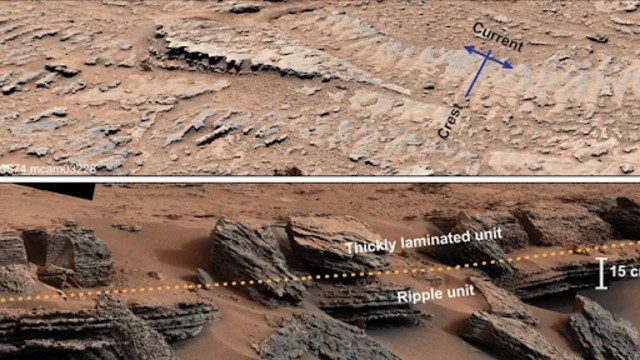
NASA's Curiosity rover found matching ripple patterns in two areas of Gale Crater on Mars. These markings suggest that liquid water once moved freely across the planet’s surface. NASA
Scientists have found new proof that Mars once had lakes with liquid water exposed to the air. This discovery suggests that not all water on the planet was trapped under ice, as some scientists previously believed.
For decades, researchers have debated how water existed on Mars. In the 1970s, NASA's Mariner 9 spacecraft captured images of dried-up channels, showing that water likely once flowed there. However, many scientists believed that any liquid water had to be covered by thick ice sheets before it vanished.
Now, new findings challenge that idea. Photos taken by NASA's Curiosity rover reveal small wave-like ripples in dried lakebeds inside Gale Crater. These ridges, known as wave ripples, only form when wind blows over open water. This means that Mars once had shallow lakes with liquid water on the surface.
Claire Mondro, a sedimentologist from CalTech and lead researcher, explained, "The shape of the ripples could only have been formed under water that was open to the atmosphere and acted upon by wind."
How Big Were These Ancient Lakes?
Scientists analyzed the ripples’ size to estimate the lakes’ depth. The tiny ridges are about 0.2 inches (6 millimetres) tall and spaced 1.6 to 2 inches (4 to 5 centimetres) apart. This suggests that the lakes were likely no deeper than 6.5 feet (2 meters).
Both lakebeds formed around 3.7 billion years ago. This means Mars had an atmosphere thick and warm enough to keep water liquid for longer than previously thought.
Could Mars Have Supported Life?
The discovery raises new questions about whether Mars could have supported life. If water stayed on the surface for a longer period, microbes could have had more time to evolve. "Extending the length of time that liquid water was present extends the possibilities for microbial habitability later into Mars's history," Mondro said.
Today, Mars is a cold desert with very little atmosphere. Scientists believe the planet once had a magnetic field, protecting it from harsh space conditions. However, over billions of years, it lost this shield. Without protection, powerful solar winds stripped away most of its carbon dioxide and water. This process left Mars dry and barren.
This new discovery could change how scientists study Mars. If water existed on the surface for longer than expected, future missions might focus on searching for signs of ancient life. The more we learn, the closer we get to understanding whether Mars ever supported living organisms.















